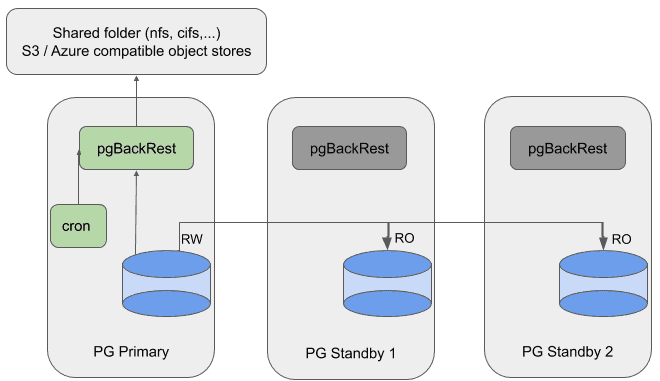Use Case 1: Running pgBackRest Locally on the Database Host
Suggest editsDescription
- pgBackRest runs locally on database servers and stores repository on remote storage (NFS, SFTP, S3, Azure or GCS compatible object stores).
- Cron task active on the node where to take backups.
- Manually reconfigure cron task to take backup from another server.

Configuration
Global Section
The [global] section will contain the:
- repository location;
- recommended settings;
- retention policy.
This section's settings should be the same for all the nodes (primary and standbys).
Mount Points
Set repo1-type to posix or cifs and specify the repo1-path location to store backups and archives on a shared space:
repo1-type=posix repo1-path=/backup_space
S3-compatible Object Stores
repo1-type=s3 repo1-path=/repo1 repo1-s3-bucket=bucket-name repo1-s3-endpoint=... repo1-s3-key=accessKey1 repo1-s3-key-secret=*** repo1-s3-region=...
The backups and archives will be stored in bucket-name/repo1.
It is possible to automatically retrieve temporary credentials when the AWS instance is associated with an IAM role. Credentials are automatically updated when they are <= 5 minutes from expiring.
To do this, instead of setting repo1-s3-key and repo1-s3-key-secret, use:
repo1-s3-key-type=auto repo1-s3-role=authrole
To automatically retrieve web identity credentials, set the repo1-s3-key-type=web-id option and define the AWS_ROLE_ARN and AWS_WEB_IDENTITY_TOKEN_FILE environment variables.
Set the repo1-s3-kms-key-id option to enable server-side encryption using the specified AWS key management service key.
Azure-compatible Object Stores
repo1-type=azure repo1-azure-key-type=shared repo1-path=/repo1 repo1-azure-container=container-name repo1-azure-account=pgbackrest repo1-azure-key=***
To use the shared access signatures, set the repo1-azure-key-type option to sas and the repo1-azure-key option to the shared access signature token.
GCS-compatible Object Stores
repo1-type=gcs repo1-gcs-key-type=service repo1-path=/repo1 repo1-gcs-bucket=bucket-name repo1-gcs-key=/etc/pgbackrest/gcs-key.json
repo1-gcs-key is a token or service key file depending on the repo1-gcs-key-type option.
SFTP repository host
repo1-bundle=y repo1-type=sftp repo1-path=/repo1 repo1-sftp-host=sftp-srv repo1-sftp-host-key-hash-type=sha1 repo1-sftp-host-user=pgbackrest repo1-sftp-private-key-file=/var/lib/pgsql/.ssh/id_rsa_sftp repo1-sftp-private-key-passphrase=BeSureToGenerateAndUseASecurePassphrase
repo1-sftp-host defines the SFTP host containing the repository. It is also possible to generate a dedicated SSH key pair for the SFTP connection using a secured passphrase with it (stored in repo1-sftp-private-key-passphrase).
Recommended Settings
Use those settings to enable encryption, parallel operations and ensure displaying enough information in the console and in the log file:
repo1-cipher-type=aes-256-cbc repo1-cipher-pass=FIXME process-max=FIXME log-level-console=info log-level-file=debug start-fast=y delta=y
Adjust the encryption passphrase and the maximum number of processes to use for compression usage and file transfer.
See the Recommended settings page for more details.
Retention Policy
To be able to delete old backups and archives, you have to define a retention policy. Use the following setting to only keep the latest full backup:
repo1-retention-full=1
See the Retention policy page for more options and details.
Stanza Section
The [demo] stanza section will be different on each database server and should contain:
- the location of the PostgreSQL configuration files
pg1-path=/var/lib/pgsql/13/data
or for EDB Postgres Advanced Server
pg1-path=/var/lib/edb/as13/data pg1-user=enterprisedb pg1-port=5444
- for every other PostgreSQL node
pg2-host=other_node_hostname_or_ip pg2-path=/var/lib/pgsql/13/data
or for EDB Postgres Advanced Server
pg2-host=other_node_hostname_or_ip pg2-host-user=enterprisedb pg2-path=/var/lib/edb/as13/data
- specific recovery option to set the replication
primary_conninfoafter the restore command is executed:
recovery-option=primary_conninfo=host=primary_vip user=replication_user ...
Setup Archiving
Once pgBackRest is configured, set up the database archiver process on each node:
# postgresql.conf archive_mode = on archive_command = 'pgbackrest --stanza=demo archive-push %p'
As changing the archive_mode parameter requires a service restart, and changing the archive_command only requires a configuration reload, we recommend enabling archive_mode with an empty archive_command (or pointing to /bin/true) when initiating a new database cluster.
See the Quick start page to set up a simple demo stanza configuration.
Assume the identity of the system user (postgres or enterprisedb) and initiate the pgBackRest repository from the primary server:
$ pgbackrest --stanza=demo stanza-create
Check the configuration and the archiving process:
$ pgbackrest --stanza=demo check
Backup and Restore
See the Quick start backups and restore sections for more details about those two commands.
Glossary
pgBackRest
delta
log-level-console
log-level-file
pg-host-user
pg-host
pg-path
pg-port
pg-user
process-max
recovery-option
repo-azure-account
repo-azure-container
repo-azure-key-type
repo-azure-key
repo-bundle
repo-cipher-pass
repo-cipher-type
repo-path
repo-retention-full
repo-s3-bucket
repo-s3-endpoint
repo-s3-key-secret
repo-s3-key-type
repo-s3-key
repo-s3-kms-key-id
repo-s3-region
repo-s3-role
repo-sftp-host
repo-sftp-host-key-hash-type
repo-sftp-host-user
repo-sftp-private-key-file
repo-sftp-private-key-passphrase
repo-type
start-fast
PostgreSQL
Could this page be better? Report a problem or suggest an addition!